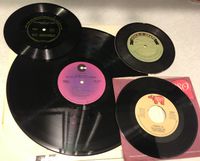Gramophone record
Dan Tobias (Talk | contribs) (→Info on transferring to other formats) |
Dan Tobias (Talk | contribs) (→Other links and references) |
||
| Line 26: | Line 26: | ||
* [http://en.wikipedia.org/wiki/Gramophone_record Gramophone record (Wikipedia)] | * [http://en.wikipedia.org/wiki/Gramophone_record Gramophone record (Wikipedia)] | ||
* [http://www.economist.com/blogs/babbage/2012/12/audio-recordings Scratch that] | * [http://www.economist.com/blogs/babbage/2012/12/audio-recordings Scratch that] | ||
| + | * [http://www.loc.gov/today/pr/2013/files/pub156.pdf Library of Congress: National Recording Preservation Plan] | ||
Revision as of 22:38, 15 March 2013
A gramophone or phonograph record is a disc-shaped object with analog audio stored in a groove (groovy!) which runs in a spiral from the outside of the record to the center, where there is usually a label and a hole in the middle to allow the record to be placed on a turntable to be played. It is played by placing a needle in the groove and starting the record rotating on the turntable, so that the needle tracks the groove and vibrates to produce sound which is amplified by a receiver. Monaural records have only one track of sound, while stereo records have two tracks represented by different walls of the groove. Records are also known as "vinyl" based on one of the materials they have been manufactured from, though not all are actually of this substance. Supplanting the early phonograph cylinders in the early 20th century, records were in turn replaced by CDs in the late part of the century as the mainstream music medium, though a niche market persists.
Early records were of variable speed, but eventually 78 RPM became the standard. At that speed and the groove density in use at the time, each side of a record would generally fit just one song, and was not long enough for longer classical pieces, which required flipping and changing records to play the entire thing. Sometimes a collection of songs would be released in a bound volume of sleeved records resembling a photo album, which is why compilations of songs sold together are called "albums" even now. In the 1950s, the long-playing (LP) record was introduced at a playing speed of 33 1/3 RPM; this slower speed and the more compact microgroove technology allowed an entire album to fit on the two sides of one record. LPs were usually 12 inches wide, but another format, 7-inch 45 RPM singles, was also introduced around the same time to hold a similar length of music to the old 78s in a smaller size. These had a large hole in the center, requiring a plastic adapter to fit it on the smaller spindle of record players designed to play the other formats as well. While 78 RPM was no longer the dominant record speed, some children's records were released at that speed as late as the 1970s. Yet another record speed, 16 RPM, was supported by some record players and used for spoken-word records where long playing time was more important than high fidelity.
Since the rise of CDs, then MP3s and other digital audio formats, vinyl records are no longer a "mainstream" format, but they have continuing interest from a community that includes some audiophiles who feel they sound better than digital music, dance and hip-hop DJs who like to "spin discs" (or sometimes make sound effects by scratching the record with the needle), and hipsters who find "retro" formats to be trendy once again. Sales of vinyl records are actually increasing lately, while CDs decline. Take those old records off the shelf!
Info on transferring to other formats
- Old records come in, CDs come out (NY Times article about machine to transfer records to CD)
- Transferring records to CD (Links to resources)
- Portable USB record player / cassette deck
Unusual uses of format
- 3D-printed record
- Record made from ice
- Record made from chocolate
- History of Echo, a magazine published on playable phonograph records from the 1950s
